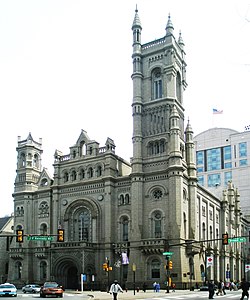James Hamilton Windrim | |
|---|---|
 | |
| Born | January 4, 1840 |
| Died | April 26, 1919 (aged 79) Philadelphia, Pennsylvania, U.S. |
| Resting place | West Laurel Hill Cemetery, Bala Cynwyd, Pennsylvania, U.S. |
| Citizenship | United States |
| Alma mater | Girard College |
| Occupation | architect |
| Spouse | Mary Barr McCutcheon Windrim |
| Children | John T. Windrim, James Hamilton Windrim, Jr., Elizabeth Windrim Flagg |
| Buildings | Masonic Temple (Philadelphia), U.S. Treasury (Philadelphia), National Savings and Trust Company (Washington, DC) |
James Hamilton Windrim (January 4, 1840 – April 26, 1919) was a Philadelphia architect who specialized in public buildings, including the Masonic Temple in Philadelphia and the U.S. Treasury. [1] A number of the buildings he designed are on the National Historic Landmarks and/or the National Register of Historic Places, including the Masonic Temple in Philadelphia and the National Savings and Trust Company building in Washington, DC.













